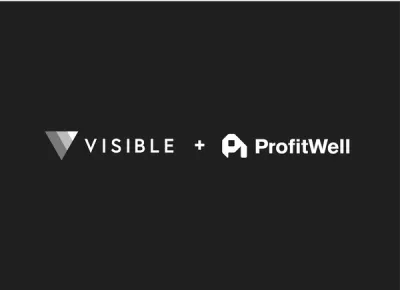Blog
Visible Blog
Resources to support ambitious founders and the investors who back them.
All
Fundraising Metrics and data Product Updates Operations Hiring & Talent Reporting Customer Stories

founders
Fundraising
How to Model Your Seed Round With Yin Wu of Pulley
Raising capital in the early days of your business can have major implications later in your company lifecycle. Yin Wu, CEO of Pulley, joined us to walk through what to consider when determining how much to raise, setting valuations, and more.
Yin joins us to talk about all things fundraising, cap tables, valuations, and dilution. You can expect to dig into some of the following topics
Who should raise venture capital
What is impacting recent valuations
Raising using SAFEs
Determining how much to raise
Setting your company valuation
How much dilution a seed company should expect to see

founders
Fundraising
Operations
Metrics and data
All Things Community-Led Growth with Corinne Riley of Greylock
On episode 6, season 2 of the Founders Forward Podcast, we welcome Corinne Riley. Corinne is an investor at the prolific venture capital firm, Greylock, where she primarily invests in B2B companies.
About Corinne
Over the course of her career, Corinne has built a knack for helping companies build and develop a go-to-market motion. Corinne has extensive knowledge of community-led growth and helping companies grow at the earliest stages of their business. Corinne joins the show to break down community-led companies and the thought process behind her investment decision-making.
Our CEO, Mike Preuss, had the opportunity to sit down and chat with Corinne. You can give the full episode a listen below:
What You Can Expect to Learn from Corinne
What a community-led company is
How community-led growth can be a moat
What the community commitment curve is
What changes between a seed and series A pitch
What data she would expect to see in a Series A company
What she likes to see in a cold email from a founder
Related Resources
Corinne’s Twitter
Common Room & Uncommon
Corinne’s post on Community-Led Growth
The Business of Belonging
Greylocks’s Visible Connect Profile

founders
Fundraising
Mike’s Note — Progressive Disclosure
Progressive disclosure is an interaction design principle that sequences screens, so users do not feel overwhelmed and inevitably bounce.
Progressive Disclosure & Fundraising
Founders should take note of this principle when reaching out to potential employees and investors. Your goal is always to get to the next step, not get hitched after 2,000 words. If you are connecting with someone for the first time, your goal should be to receive a response. Keep things between 50 to 250 words (just like this note).
As Kunu says, do less.
Use Visible for Your Next Fundraise
No matter the series, size, or timing of your round, Visible is here to help. With Visible, you can manage every stage of your fundraising pipeline:
Find investors at the top of your funnel with our free investor database, Visible Connect
Track your conversations and move them through your funnel with our Fundraising CRM
Share your pitch deck and monthly updates with potential investors
Organize and share your most vital fundraising documents with data rooms
Manage your fundraise from start to finish with Visible. Give it a free try for 14 days here.

investors
Hiring & Talent
How to Hire for Your First VC Platform Role
What is a VC Platform?
First off, if you’re reading this article because you haven’t fully wrapped your head around what a VC Platform is, that’s ok. The term Platform is still relatively new in the VC world with the first VC Platform roles being formalized around 2013.
The term VC Platform can be defined as formalized post-investment support and services that VCs provide to their portfolio companies to help increase their chances of success and differentiate the VC firm.
Stephanie Manning from Lerer Hippeau decoded the VC Platform role and explains that a Platform role (or roles) vary by title but responsibilities typically fall into these six buckets:
Talent
Business Development
Content, Marketing & Communications
Community & Network
Operations
Events
In sum, Platform roles help formalize the post-investment support processes and make them repeatable and reliable.
This image is from the Lerer Hipeau Blog Post Paths into Venture Capital: Decoding the VC Platform role.
Related resource: How to Get Into Venture Capital: A Beginner’s Guide
Why VC Platforms Roles Exist
VC Platform roles exist for two main reasons —
To scale support — Investors get spread thin as their portfolios grow and they need a way to scale their support.
To differentiate one firm from another — At the end of the day, VC’s are all selling the same product, capital, and need a way to differentiate themselves to attract deal flow.
Different VC Platform Approaches
Although the objectives of all VC Platform roles are the same (see above), VCs take different approaches to Platform based on the needs of their portfolio, available resources, and differentiation strategy.
If you’re hiring for your first Platform role, it’s likely you don’t have a Platform strategy defined yet. This is completely ok to start, but would heed the advice from Jay Acunzo from NextView Ventures and note that “platform only works when you’re known for something”.
Acunzo goes on to suggest the following:
Firms with broader investment strategies should pick another focus area to ensure platform success, whether by owning a tactic (e.g. workshops, video, etc.), a business function (e.g. recruiting, design) or a sector (B2B SaaS). Even if a firm invests outside that industry, it’s still a better approach to be truly meaningful to one audience than mostly forgettable to many.
With this in mind, right before or right after your first hire, you should be thinking about where portfolio needs, available resources, and your VC brand align.
Check out our post on Defining your VC Platform Approach which includes a VC Platform Positioning Exercise template to kick off your brainstorming.
What to look for in your first VC Platform Role
Although you’ll eventually want your Platform to specialize and “be known for something” if you don’t know what that “something” is yet, we suggest looking for someone with marketing, events, or recruiting experience as a first hire. Previous experience with startups or working in Venture Capital is a major bonus but making it a requirement may narrow your search significantly.
Jack-(or Jill)-of-all-trades type often do well in platform roles because they’re going to be wearing several hats at once. When interviewing candidates look for someone with a proven record of creating things from scratch (from idea to implementation) because you’ll want to find someone who has the ability to try out a few different approaches to post-investment support and be ok when some flat-out don’t work.
They’ll also need to be a persuasive communicator because they will need to convince both your investment team and your companies to try new ideas.
And finally, as you think long-term about how your portfolio and Platform will grow, you may envision this person managing a Platform team. Therefore, it’s a good idea to hire someone who has the organization and leadership skills required to lead a team.
A summary of traits to look for:
Building relationships is second nature
Enjoys organizing events and bringing people together
Takes a creative approach to problem-solving
An idea generator AND executor
Ability to wear multiple hats and remain organized
Previous experience working with startups or at a startup
Can deliver on projects with little guidance from others
Demonstrated ability to communicate effectively and persuasively
Aptitude for managing a team
Writing the VC Platform Role Job Description
To get started with writing the job description for your first VC Platform role, it’s a good idea to check out real examples from other firms.
Here you can find a public-facing VC Platform Job Board which includes job descriptions for various types of Platform roles.
You could also utilize LinkedIn and search for VC Platform Manager or Director of Platform to view open roles from other funds.
How to set your VC Platform Manager up for Success
You may find managing someone in a Platform role to be challenging from the perspective that their work may seem unrelated to the focus areas of other fund staff. And that’s because it is.
Ask any first Platform hire and they will undoubtedly tell you they felt isolated and even lonely in their role. This is why it’s critical to encourage the new hire to create their own peer network of people in platform roles outside of the fund. This network can also help them upskill more quickly and have people who understand their work to bounce ideas off.
Thankfully, a welcoming community of people like this already exists. The VC Global Platform Community is a network of people in platform roles around the world who connect virtually (via a forum, video calls, and events) to discuss best practices, exchange ideas, and foster relationships.
You can additionally support the new Platform hire by backing them up when they want to implement new ideas and need buy-in, and ensuring there are opportunities for them to be heard. A Platform person’s nightmare is being excited about rolling out a new idea but not being able to get the ‘air-time’ with relevant team members to push it forward. As a manager, you can keep this communication channel open by setting up a regular (try quarterly) meeting between the Platform hire and the investment team to discuss post-investment support initiatives and decide on next steps.
Consider using Visible.vc’s portfolio reporting tools to increase transparency between your Platform team and Investment team.
And finally, your new Platform hire will want to know their work is making a difference. It’s a good idea to challenge them to come up with their own method for defining and measuring success for improving and formalizing your fund’s post-investment support. Check in with them about these goals on an agreed upon cadence.
Hiring your first VC Platform role is a great way to scale the post-investment support you offer your portfolio companies and to differentiate your fund from the sea of other capital providers.
However, it’s not always easy given this hire will be working on initiatives that other staff members haven’t previously dedicated much time or resources to. But with the right person, and by being intentional about setting them up for success, this new hire can add immense impact to your fund’s performance.
Visible for Investors is a founder-friendly portfolio monitoring and reporting platform.

investors
Operations
Defining Your VC Platform Approach Using the TOPSCAN Method
You may be interested in better defining your VC Platform approach because you’re thinking about hiring for your first Platform role or you want to strategically determine where to allocate more resources to improve your post-investment support. Whatever the reason, it’s a worthy investment of your time because your VC Platform can help set you apart from other investors in a competitive deal flow environment.
Despite the importance of the topic, not very many frameworks exist to help investment teams and Platform teams figure out how to improve the support they’re providing startups. This article highlights the TOPSCAN method and serves as a useful tool to take a wide lens view at the needs and resources that already exist within your portfolio today.
What is the TOPSCAN Method for Startup Support?
The TOPSCAN method for supporting startups is a hidden gem of a framework first outlined in 2013 in The Journal of Private Equity. It was designed to help investors improve their operational support of startups.
The framework includes seven key management techniques as outlined below:
Using this framework, and the exercise outlined below, you can strategically determine the areas of support that will deliver the most value to your companies and reap the most return for the investment of your VC Platform’s time and non-capital resources.
Using TOPSCAN to Identify your VC Platform Positioning
The objectives of VC Platforms are all about formalizing the post-investment support processes and making them repeatable and reliable. Therefore, you want to make sure you’re scaling your most impactful areas of support.
To discover which areas of support are going to be the most valuable to scale from both your portfolio’s and your fund’s perspective, you should be thinking about where portfolio needs, available resources, and VC brand strategy align.
To do this, consider using this VC Platform Positioning Exercise template as a guide.
VC Platform Positioning Exercise
Portfolio Needs
To get started, navigate to the Portfolio Needs column on the VC Platform Positioning Exercise. Here you’ll begin to answer the question What is the most impactful support you could be providing your companies?
The exercise starts with this column because it is absolutely critical to have a finger on the pulse of what is top of mind for your portfolio companies.
Just as you would never advise one of your portfolio companies to build a product without first understanding their customer, you need to understand your portfolio companies (read: customers) before you start building out your VC Platform approach.
To do this, you could consider:
Sending out a survey;
Using Visible.vc’s Request feature to streamline the collection of qualitative responses; Or
Scheduling a check in call with your founders during which you ask ‘what is the most impactful way we can support you’*
*If you don’t have strong relationships with companies already in place, start by setting up informal check in calls to build rapport instead of a survey.
Document the trends you see emerging across the portfolio using the TOPSCAN categories of support which are included in the VC Platform Positioning Exercise. You’ll also want to assign a weight to each category according to the level of demand or need. Portfolio Needs Example:
Available Resources
Next, review and consider which resources for company support already exist at your firm. Your goal should be to answer the question What resources do we have internally and/or how could we source these externally?
Start mapping out these resources by the TOPSCAN category they’re related to. Take into account which resources your VC Fund has internally versus where it could make sense to partner with a service provider. Assign a weight related to how available the resources already are within your firm.
For example, your portfolio may need help with recruiting but you don’t have resources on staff to support this. In this case, you may consider whether there is a budget to adopt a software or form a partnership to provide this type of support to your companies. Available Resources Example:
Brand Strategy
And finally, it’s important to keep in mind your fund’s brand positioning to make sure the resources you’re allocating align with your brand. In this section you’re answering What do we want to be known for?
As Jay Acunzo from NextView Ventures notes “platform only works when you’re known for something.”
Brainstorm within your team until you’ve clarified what it is you want to be known for. Do you want to be known for data-driven decision making? Or maybe you want to be known for identifying and investing in diverse teams. Denote this in the ‘Brand Strategy’ section of the exercise and again assign a weight to each category as you fill them out. Brand Strategy Example:
Once you’ve completed the VC Platform Positioning Exercise, begin looking for overlaps in portfolio needs, available resources, and brand strategy. The areas in which you identify the most alignment should form the basis of your VC Platform approach.
And as Peter Drucker once said, “You cannot manage what you don’t measure”. Be sure to set up KPI’s for your newly defined VC Platform approach so you can measure, analyze, and iterate as needed to refine your approach overtime.
And with building anything new, keep in close communication with your ‘customers’ so you’re confident you’re building something of value.
Other VC Platform articles we love:
Paths into Venture Capital – Decoding the Platform Role
Director of Platform, what does that mean?
Why VCs are investing in Platforms to Compete
Are Newly Formed Roles In VC Firms Differentiators, Table Stakes Or Total BS?

founders
Fundraising
Operations
How Starting Line Helps Founders Address Their Mental Health with Ezra Galston
On episode 5, season 2 of the Founders Forward Podcast, we welcome Ezra Galston. Ezra is the founder and partner at Starting Line, a consumer-focused VC fund located in Chicago.
About Ezra
As someone who has faced the ups and downs of being a founder (plus the stresses of fundraising), Ezra and the team at Starting Line has made mental health a focus. Every founder in the Starting Line portfolio receives a subsidy for “their first three sessions of therapy, executive coaching, or co-founder counseling (up to $200 each).” Ezra joins the Founders Forward to break down fundraising, founder health, and the consumer market/what excites the team at Starting Line.
Our CEO, Mike Preuss, had the opportunity to sit down and chat with Ezra. You can give the full episode a listen below:
What You Can Expect to Learn from Ezra
How a founder and board’s focus changes from early stages to later stage
How venture fundraising differs for the “haves” and “have nots”
How Ezra’s experiencing raising capital has impacted how he views fundraising
Why Starting Line has a focus on their portfolio founder’s mental health
How Starting Line subsidizes mental health sessions
Why fundraising is a relationship-based activity
Why he likes plenty of context before a meeting with a founder
Related Resources
Ezra’s Twitter
The Starting Line Operating Manual
Starting Line’s Visible Connect Profile

founders
Operations
Reporting
How To Build a Board of Directors That Actually Helps
What a Board of Directors Does
Even with great executives, a great product, and a great team, the success of a new startup can be determined by its Board of Directors. Choosing a Board of Directors is a critical process. The Board of Directors for your venture are the strategic advisors or final votes in major decisions and changes. With the right Board in place, a company can accelerate and take the right strategic steps to a favorable exit or IPO.
Building a Board of Directors is a crucial process and one that should be done deliberately and strategically. Decisions about the type of board your company needs, the types of board members and how they will strategically work together, and planning ahead for potential board obstacles and stumbling points are all aspects to consider when building a Board of Directors that will actually help your company grow.
What a Board of Directors Does
At the highest level, a Board of Directors provides some type of strategic advisory and decision making for a company. In some cases, and for some types of boards, this decision-making could be fiscal and provide the board members the electoral power to make changes above the company’s executives. In other cases, it can be purely strategic, with no formal and final power but rather to serve as a collective of experience and guidance as the company grows and evolves over time. In general, a Board of Directors serves as a voting or advisory body of appointed or elected leaders that help make decisions for a company. There are nuances and three primary types of Boards of Directors.
The Different Types of Boards
Board of Directors
A Board of Directors is made up of appointed members typically representing from inside the company and outside the company. Board of Director members are experts in their field, fields relating to company leadership or aligned strategically with what a company does or what industry they serve. A Board of Directors may serve in an advisory role or a fiduciary role or both. These two types of boards are most common. Inside company representation may include leaders of the executive board and even the CEO of the company. Outside appointees vary depending on the type of Board of Directors. The type of board of directors can also influence how a specific board meeting is run. Check out our guide on How to Run a Board Meeting to learn more about the various meeting flows.
Advisory Board
The main differentiator of an advisory board is that its decisions are non-binding and more informal in nature. Just as the name suggests, Advisory Boards are composed of appointed experts that provide advice and help a company with forward-thinking decisions such as custom acquisition, go-to-market strategy, category tactics, pricing, or even acquisition decisions. Advisory Board cannot force a CEO or executive team to take any action. They are also not appointed to represent any specific interests, rather composed of folks that are experts in their field or have strong track records of scaling great businesses. Sometimes, in exchange for an Advisory Board seat and contributing their time and help to a company, the stock is given as part of the “payment” for serving in an Advisory Board role. This also ties the advisory board member to the company’s long-term success. In general, Advisory Boards do not assume any liability or responsibility legally from company decisions and outcomes.
Fiduciary Board
First and foremost, Fiduciary Boards are made up of an equal representation of all the shareholders, not just majority owners. Public companies are required to have Fiduciary Boards but Private companies are not. Fiduciary Boards are tasked with ensuring that the company is making decisions that are fiscally beneficial to its shareholders. Because of this heavy responsibility and oversight, Fiduciary Boards are given the voting rights to overrule the CEO’s decisions. Members of a Fiduciary Board are appointed by each party they represent. Often, when a big funding round takes place, the leading investor of that round will appoint a partner to sit on the Board of Directors at the company – earning a board seat as part of their investment to represent their fiduciary interests. Inside the company members are present as well including the CEO and possibly another C-level executive.
The Different Types of Board Members
Not only are there different kinds of Boards of Directors, there are also a variety of different types of board members that make up said boards.
Management Board Members
Internal representatives on a Board of Directors from the company are referred to as management board members. Management board members are direct representatives from the day-to-day of the company, often the CEO, COO or another executive leader. They provide the frontline perspective into the discussions and decision-making for the board and are often responsible for running the agenda and managing the flow of information out to the rest of the board members.
Investor Board Members
Often, when a VC firm or PE firm makes an investment into a company’s funding round, they are granted representation with a board seat. Investors that join your board at different stages of a company’s growth may have different perspectives or rationale around upholding specific decisions or fiduciary responsibility. It’s critical that you spend the time onboarding not only the board seat holder, but your broader team of new investors after every round.
Independent Directors
Knowing that management members and investor members both have direct ties to the success of the company and are personally tied financially to the outcomes decided on by a board, independent directors provide an air of checks and balances to the table. Independent directors are qualified individuals that have no affiliation or tie to the company. They may be business leaders or industry experts and are there as a 3rd party, non-bias advisors to the business.
How To Build a Strong Board of Directors
Now knowing that there are various types of a Board of Directors and various members that make up those ranks, the decision-making process begins to form the perfect board for your company’s needs and future.
Choosing a Board Type
First and foremost, if your company is public, a fiduciary board is required. However, if your company is private, you have the option to build a board with just advisory duties or to grant them fiduciary power as well. It’s important to consider why each function exists. Choosing an advisory board is smart for any founder to make sure their company building does not exist in an echo chamber, and insight and advice is considered early and often as the company scales. The more external funding you take and the more shareholders are present, fiduciary responsibility may make the most sense to protect the overall interests of the company and spread out the risk and legal responsibility amongst shareholders, not just on the executive leadership at the company.
Deciding on a Board Size
There is no mandatory set number of Board Members, and most range from 3 to 31 employees. Typically a board is always composed of an odd number to prevent tied votes. Analysts suggest that the ideal Board of Directors size is 7 members. Deciding on your Board size is up to you as a founder. Perhaps a smaller board is good to start with expansions being made as more investors come to the table, earning more seats, or as new problems or growth opportunities arise at the company that requires new expertise to be brought in.
Establishing a Board Structure
In addition to Board of Directors Size and Type, the structure of the board is critical to the success of the board. Having a clear, and defined structure that is agreed upon by members as they join ensures that board meetings are run smoothly and the purpose and goals of the board are clearly achieved. Structural elements of a board to consider include setting clear bylaws that outline member responsibilities and expectations, defined roles, and duties such as who will take minutes, who will report out, and who will run the meeting flow at each board meeting. Term limits are also something to consider, especially for a fiduciary board, to keep decision-making ethical and tied to the best interests of the shareholders. Additionally, check if your specific industry or board type has any industry or corporate governance rules that are needed to be abided by.
Fill Knowledge and Skills Gaps
When appointing new board members, or even just as you appoint the first few board members, consider what skills they bring to the table and how they can best aid your company’s success. If there are gaps that the current management team or founders of the company have, a board of directors can help fill knowledge and skills gaps. For example, if the founders of a company are technical, they may want to build an advisory board of directors with go-to-market experts, revenue leaders, and financial advisors to ensure that the business decisions are made in conjunction with the great product evolution or development taking place. On the flip side, if a company is expanding into a new industry or adding a product line, an expert in that product field or industry may be a crucial knowledge gap to fill with a board seat.
Prioritize Diverse Perspectives
The best way to make sure your business actually grows from implementing a board and making forward-thinking decisions as a board is to avoid an echo chamber. An echo chamber refers to the same ideas or thoughts being “Echoed” back many times over. Often, it’s easy to be drawn to like-minded leaders or partners you’ve worked within the past when selecting board members. However, think more about the qualities and traits and perspectives the management members or already selected members bring to the table. Then try and find a completely opposite perspective or experience (that still helps your business). Avoiding an echo chamber will ensure all perspectives and sides of an idea are considered when making a decision and avoid obvious mistakes that might be made if everyone can only see one direction clearly.
Onboard Your Directors
Plain and simple, onboard your Board of Directors. Just as you would likely build out a comprehensive onboarding plan for your new employees so they have everything they need to do their job, the Board of Directors are no different. Provide a detailed, comprehensive, and repeatable path for onboarding for your Directors. This will ensure everyone is on the same page and has a clear understanding of the “why” that brings them to the table for your company each and every day.
Regularly Evaluate Your Board
If the board type and structure is set, all your Directors are onboarded, and you have your Board up and running, don’t stop thinking about what your Board’s ideal state looks like. Make quarterly and annual evaluations a habit with your Board to ensure that all members are continuously able (and willing) to serve in their Board role at full capacity. This ensures that your Board remains a valuable part of your business’s strategy and success.
Potential Obstacles to Your Board’s Success (and Solutions)
Despite taking all the steps to build a strong Board of Directors, be aware of potential obstacles to your board’s success.
Too many like-Minded Members
When building your board, especially early on, the board may be small. Between management members and investor or industry expert appointees, you always run the risk of having too many like minded members on the board, preventing any real change or growth to be done. The best solution to avoiding this potential obstacles is to be really intentional when building your board to diversity the perspectives represented and to set clear term limits for your board. That way, even if after working to select members with diverse perspectives, there is a second safety net in place to ensure that after a set number of time, board members will be interchanged to bring in even more perspectives and prevent a like-minded board from forming.
Conflicts of Interest
Another common obstacle many Boards of Directors face is a conflict of interest among board members. This could be due to too much management representation on the board or possibly too many friends and family represented on the board as shareholders. A solution on the management side is to ensure there is a cap on how many management members are represented at any one time on the board. This limit will prevent the management perspective from taking over. Similarly, term limits, or voting rules around stakeholder involvement can help ensure that decisions are made fairly and not just in the interest of the individual board member.
Let Visible Help
A Board of Directors can be game-changing for your business and completely shape the strategic direction to take a company public or through other favorable business outcomes. Once your Board is up and running, it’s important to ensure communications to the Board are seamless and clear. Learn more about keeping your investors updated with Visible here.

founders
Fundraising
Operations
Customer Stories
Building a Calm Company with Tyler Tringas
On episode 4, season 2 of the Founders Forward Podcast, we welcome Tyler Tringas. Tyler is the founder and General Partner at Calm Company Fund (formerly Earnest Capital). The Calm Company Fund invests in exactly what it sounds like — “profitable, sustainable, calm businesses.”
About Tyler and Calm Company Fund
Tyler offers a unique perspective as someone who invests in companies that may not be the huge companies that a traditional venture capitalist eyes. He joins us to break down what exactly a “calm” business is, the current market dynamics that are creating more need for funders like Calm Company Fund, and much more.
Our CEO, Mike Preuss, had the opportunity to sit down and chat with Tyler. You can give the full episode a listen below:
What You Can Expect to Learn from Tyler
How companies in smaller markets can still be winners
What a SEAL is and how Calm Fund uses them
The market dynamics creating a need for more funding options like Calm Fund
Why and how they raised crowdfunding
How Calm Fund and Venture Capital can co-exist for startups
How to best cold email investors
Related Resources
Tyler’s Twitter
Calm Capital — What We Invest In
Shared Earnings Agreement
Our Original Sit Down with Tyler
The Calm Fund Visible Connect Profile
Bootstrapping 101: Pros & Cons of Bootstrapping Your Startup

founders
Fundraising
Reporting
How to Create FOMO During a Fundraise with Elizabeth Yin of Hustle Fund
On episode 3, season 2 of the Founders Forward Podcast, we welcome Elizabeth Yin. Elizabeth is the founder of Hustle Fund, a venture fund for “hilariously-early founders.”
About Elizabeth
As a past founder and current investor (and a founder favorite Twitter follow), Elizabeth knows what it takes to successfully raise a round of venture capital. Elizabeth breaks down how founders can leverage tranches, raising from small funds and angels, and shares other tactical tips to knock out your seed round.
Our CEO, Mike Preuss, had the opportunity to sit down and chat with Elizabeth. You can give the full episode a listen below:
What You Can Expect to Learn from Elizabeth
How to raise capital from angels
How small checks can lead to big checks
How tranches can be an effective way to raise capital
How tranches and meeting cadence can create FOMO
Why you should have a 5 slide deck
What changes between a Seed and Series A round
How to get the attention of an investor via cold email
Related Resources
Elizabeth’s Twitter
Hustle Fund’s Connect Profile
AngelSquad by Hustle Fund

founders
Fundraising
Reporting
Customer Stories
Creating Momentum in Your Fundraise with Brett Brohl
On episode 2, season 2 of the Founders Forward Podcast, we welcome Brett Brohl of Bread & Butter Ventures. Brett is the Managing Director of Bread & Butter Ventures as well as the Managing Director of the Techstars Farm to Fork Accelerator.
About Brett
As a past founder and current investor, Brett has a wealth of knowledge on how founders can best create momentum during a fundraise. Give Brett a listen as he walks us through best practices to build out a fundraising process.
Our CEO, Mike Preuss, had the opportunity to sit down and chat with Brett. You can give the full episode a listen below (or in any of your favorite podcast apps).
What You Can Expect to Learn from Brett
How to determine if VC is right for your business
How much time you should allocate for a raise
How to model financials for a fundraise
How to leverage investor Updates to speed up a fundraise
Why you should send a 4 slide pitch deck before a meeting
How you should think about moving investors through your funnel
Related Resources
Brett’s Twitter
Brett’s Fundraise Faster Video Series
Troy Henikoff Financial Modeling Series
The Bread & Butter Investor Update Template
Bread & Butter’s Profile on Visible Connect, our investor database

founders
Fundraising
Reporting
The Supply & Demand of VC with Kenn So of Shasta Ventures
On the first episode of season 2 of the Founders Forward Podcast, we welcome Kenn So of Shasta Ventures.
About Kenn
Kenn is an associate at Shasta and invests in B2B enterprise software companies (with a personal focus on Machine Learning).
Kenn joins the Founders Forward to break down the trends taking place that are influencing company valuations. We also dig into how founders can leverage investor updates and cold email to create momentum in a fundraising process.
Our CEO, Mike Preuss, had the opportunity to sit down and chat with Kenn. You can give the full episode a listen below (or in any of your favorite podcast apps).
What You Can Expect to Learn from Kenn
Why founders should take the time to pitch associates
The supply & demand of venture capital that are impacting valuations
Why the emergence of “mega-funds” is changing the VC landscape
The risk of raising at too high of a valuation
How to create momentum in a fundraising process using an email newsletter
What he likes to see in a cold email from a founder
Related Resources
Kenn’s Book, “Breaking into Early-Stage VC“
Kenn So on Tech Valuations
Kenn’s LinkedIn

founders
Metrics and data
The State of Revenue Retention With Patrick Campbell
What is the best way for a SaaS company to grow? According to ProfitWell, “Acquisition is the weakest growth lever. How do we know this? We studied the levers—acquisition, retention, and monetization—of 23.4k SaaS companies. We found that monetization and retention have much higher revenue impacts than acquisition when considering the same level of impact across each growth lever.”
In this webinar you’ll learn:
How retention can boost your business
Best practices to improve retention
What ProfitWell has learned from surveying 23k+ companies about retention
The new Visible + ProfitWell integration
Why you should send an investor update

founders
Operations
4 Ways To Find the Perfect Startup Co-Founder
Founding a company is no easy feat. From idea to execution, it can be almost impossible to get up and running as an actual, legitimate company and that’s just the beginning. Across all industries, 90% of startups fail and 10% of startups fail in the first year alone. The odds are stacked against you and only the bravest (and maybe craziest) folks choose the path of entrepreneurship and founding their own startup.
Going this road is risky and daunting so often it makes sense to bring on additional support, a co-founder or multiple co-founders, to join in on the wild ride of launching and building a startup. However, it’s not always clear when bringing on a co-founder is right. Timing, needs, trajectory, bandwidth, and business outcomes should all be considered when thinking about what a co-founder could mean for your business’s success (or failure).
So how do you know when you need a co-founder and how do you find the right one for your business? The Visible team has outlined 4 ways to find the perfect startup co-founder.
How Do You Know if You Need a Co-Founder for Your Startup?
There are no one-size-fits-all perfect way to run a startup. Some founders are successful on their own, hiring a great leadership team around them. Others make the choice to bring on a co-founder or group of co-founders early in the business. So how do you know if you need a co-founder for your startup? Consider two main categories, what stage your business is at and what your competencies are as a founder.
Not every founder (or every business leader) is perfect at every task that a founder needs to learn. Some founders come to the table with a product and technical strength – the how and the possibility of what’s feasible with your new idea is clear in your mind. Other founders come to the table with business acumen – maybe they’ve founded a company before or lead a company in the c-suite through major milestones like fundraises, acquisitions, or even IPOs. Still, other founders excel in an area of expertise that their new tech startup fits into. For example, maybe a 20-year restaurant management vet wants to start a startup focused on restaurant tech. They bring industry knowledge and even some business acumen to the table, but are missing the technical and the startup funding knowledge that may be needed.
Some founders choose to stay the course and work through the areas they aren’t experts in alone or with the guidance of trusted advisors. It is critical to go into your startup as a founder to understand your strengths and where you might be missing skills.
Taking an assessment of personal strengths and areas of competency is a great way to decide if you need a co-founder. A co-founder with another set of skills or expertise can help round out your startup and increase your odds for succeeding right out of the gate. This can also be done with early hires, but there are some unique benefits that come with purposefully choosing someone to co-found a startup with you instead of just joining as an early team member.
Check out why Yaw Aning, Founder of Malomo, believes it is important to find a co-founder below:
Why You Should Consider a Co-Founder
After you’ve identified that there are some core pieces of knowledge missing from your team as you move to found a startup, there are some key reasons why you should consider a co-founder to join the team instead of just making specifically skilled early hires.
Commitment to the Vision
With the ups and downs a startup can bring, commitment is critical for early team members. A co-founder is more bought into the vision of your startup than an early hire. They are tasked with helping to shape the vision, typically have the opportunity to grab major equity options, and have the responsibility of shouldering the success or failure. An early hire may be committed and you may even give them great stock options, but their ideas and direction aren’t shaping the business in the same foundational way. When things get tough, they can jump ship with a lot less hesitation. Understanding how startups go about splitting founder equity is important in understanding how committed a co-founder will be to your business.
Move Fast
Sharing the responsibility of the quick, high-stakes decisions that must be made while launching and growing a startup can help your team scale faster, saving time and money. Knowing you have a trusted partner to take ownership of parts of the business will allow more to get done simultaneously. For example, a technical founder can help lead the engineering and product decisions while a business-minded or CEO partner can focus on fundraising and scaling a GTM plan. It becomes much easier to move fast with multiple folks leading in lock-step.
Get Unstuck
As you move fast and scale your vision, roadblocks will pop up. A co-founder or multiple co-founders ensure that there are multiple folks with the same stake and commitment to the business ready to solve these challenges. Board members and investors (as you develop and bring on those partners) will have perspectives, advice, and even an ideal vision but a co-founder can help keep you focused and is a built-in, strong sounding board to move through the inevitable challenges that founders face.
What to Look for In a Co-Founder
Maybe you’ve thought about it and you do want to seek out a co-founder for your startup. But what exactly makes a good co-founder? Strong co-founders should have indispensable skills and experience, a complementary and collaborative mindset, and a clear vision and commitment to the company you’re planning to build.
Skills and experience
Reflecting back on identifying your own core competencies as a founder, whether you’re seeking out a co-founder with a very specific skill set or a complimentary one, looking for a co-founder with a background of skills and experience is key. In some cases, friends from college or young entrepreneurs are able to scale a successful business. But that is the exception, not the rule. In most cases, choosing a co-founder with skills and expertise in the competency area you are looking for, as a successful previous founder or business leader, or an impressive resume of wins and experience in the space your startup will play are good guidelines to follow in your search.
Complementary and Collaborative Mindset
Co-founders spend an unimaginable amount of time working together. Understand your working style and strengths and make sure you partner with a co-founder that you can work well with and who brings ideas and a drive to work together to the table. You might have the most skilled and experienced candidate on the table but if the energy between co-founders is off, the collaboration and execution just won’t get done or will be a very painful process to go through day after day.
Commitment
Is the person you’re considering bringing on as a co-founder a startup hopper? Are there weird gaps on their resume or unexplained reasons for exciting startups (outside of the reasons that startups fail 90% of the time)? Every founder is looking to be that 1 in 9. Best case, you take your startup all the way to a successful conclusion of acquisition or IPO. Looking for a co-founder with a track record and personality that can remain committed to the vision of your startup through all ups and downs is critical. Additionally, it’s important that any co-founder you take on has a passion and excitement for the problem you’re solving. The nitty-gritty will get stressful and even boring at times, but the commitment to growth and vision, what COULD be, will help any co-founder team preserve.
4 Ways to Find the Right Startup Co-Founder
Take Advantage of Your Network
Think about all the great networks and experiences you’ve been a part of in your career. From alumni networks at undergrad or business school to your LinkedIn connections, chances are someone in your circle knows someone looking to join the startup founder game too. Folks are always open to connecting with others so starting within the circles you feel comfortable with is a great place to start searching for a co-founder. Nobody knows you better than folks you’ve worked with or had personal experiences with. The perfect person may only be a degree or two connection away so put those feelers out in your network first.
Network in Your Startups Industry
Starting a company focused on the hospitality industry? Maybe the finance space? There are plenty of online groups on LinkedIn or on Slack as well as in-person associations and meetup groups that are industry-focused. Joining a few industry associations or networking calls can help you find a co-founder with the expertise and passion in your new industry space.
Look for Advisors
While it may not make sense to bring on a co-founder at the very beginning of your startup, start by bringing on a few trusted advisors and confidants to provide guidance and collaboration that a founder would. As you refine your work style and vision for the company, one of these advisors or collaborators could turn into a co-founder or after working with you, feel comfortable and excited referring to someone in their network to be considered for the partnership.
Find Founder-Focused Communities
In addition to networking in your personal circles and engaging with industry-focused events, there are many events specifically for founders. Some VCs and even top tech cities will host “founder speed dating” or “founder networking” events for current founders or past founders seeking to meet and build a network of collaborators and advisors or even as a place to meet others interested in founding a startup together.
Conclusion
All in all, outside of maybe how you choose to fund your startup, the decision to bring on a co-founder (or not!) is one of the most important decisions you will make in the early stage of a startup. It’s a decision that if executed correctly, can result in a great long-term partnership, allow for faster growth, and provide long-term success for your business. Start with our 4 ways to find the perfect startup founder and let us know how your startup journey goes. Happy founding!
Interested in learning more about the foundations of a startup and how to measure success from the very beginning? Chat with the Visible team here.

founders
Metrics and data
Product Updates
Unlock Your SaaS Metrics with Visible & ProfitWell
Keeping tabs on your SaaS metrics, like subscription growth, MRR movements, churn rates, etc., is vital to continued growth and improvement. We are excited to announce our direct integration with ProfitWell to do just that.
About ProfitWell
ProfitWell is a free tool that provides SaaS metrics insights, helps reduce churn and optimize pricing. Visualize your ProfitWell data directly in Visible, share it with your most important stakeholders, and combine it with other data sources to understand how your subscription growth is impacting your overall business.
ProfitWell + Visible
Our integration with ProfitWell allows you to sync 39 metrics to your Visible account (learn more about them here). Check out a few examples of different charts and data you can pull into Visible below:
With ProfitWell, you can bring in all of your recurring revenue movements — new, upgraded, downgraded, churned. If you’d prefer to not share such granular data with your investors (and potential investors), you can also pull in your current recurring revenue which may look something like this:Alternatively, you can also chart your customer count movements to get a look at how your customer base is growing.
How SaaS Metrics Help Fuel Growth
ProfitWell has taken an added focus on leveraging your current customer retention to fuel growth. As they put it, “Acquisition is the weakest growth lever. How do we know this? We studied the levers—acquisition, retention, and monetization—of 512 SaaS companies. We found that monetization and retention have much higher revenue impacts than acquisition when considering the same level of impact across each growth lever.”
Keep tabs on your retention directly in Visible. If you’d like to learn more, make sure to save a spot in our webinar with Patrick Campbell, CEO of ProfitWell, as we discuss all things churn and retention.
Learn more about connecting ProfitWell Don’t forget you can combine your ProfitWell data with any of our other integrations as well.
P.S. We are hosting a webinar with Patrick Campbell, the CEO of ProfitWell, on July 7th to discuss all things net revenue retention and churn. Save your spot here.

founders
Fundraising
How to Pitch a Series A Round (With Template)
When is the right time to raise a Series A round of funding?
You made it past your initial seed funding round which means you successfully raised money on a story that got your investors excited about you as a leader and the vision of what you were building. You then turned that capital into a solid customer base, consistent revenue, or are hitting other KPIs relevant to your company and now you’re thinking about raising your Series A. At this point, you may be wondering when to start the fundraising process, how investor expectations have changed, and how to get in front of the right investors.
You are right to be asking yourself all these questions and mentally preparing to transition to a full-time job of fundraising. The reality is, Series A financing is much harder to obtain than seed financing. First Round Capital shares a founder’s perspective, “Our seed round was super fast and hyper-competitive, and then we went into the A and started getting interrogated about our data. It was like graduating from elementary school and going straight into college.”
To better understand how investors are thinking about the A round, Andrew Chen of Andreessen Horowitz distilled the early-stage investment thesis into this:
Pre-seed – Bet on the entrepreneur
Seed – Bet on the team
Series A – Bet on the traction
Series B – Bet on the revenue
Series C – Bet on the unit economics
There’s no getting around the fact that Series A are the new Series B and the heightened competition for capital at this stage means you need to go into the Series A fundraising process equipped with the knowledge and a level of preparedness that will set you apart from the others.
The right time to kick off your Series A fundraising process is… before you think. It’s a rare breed of founder that will tell you they closed a financing round in LESS time than they thought it would take.
Y Combinator suggests kicking off your fundraising when you have 9 months of runway left but you should be nurturing informal relationships with investors before then (view prospective Investor Update templates here). Additionally, you should always have a finger on the pulse of your burn rate and how it influences your runway. If you don’t know your key metrics cold, you’re not ready to fundraise.
Recommended Reading: The Understandable Guide to Startup Funding Stages
What if you’re running out of cash but still not hitting Series A benchmarks?
With the hurdles for Series A financing reaching new heights, it’s good to think about whether you’re really ready to set these types of expectations with investors. If not, it’s becoming more common for startups to raise seed extensions (Seed II, Seed Extension, Pre-A, etc) to supplement their growth until they are able to hit the milestones that Series A investors are looking for. If this sounds like you, be sure to know the difference between a bridge round and post-seed round.
The name of the financing round will attract different types of investors so be sure to consider this early on when developing your fundraising strategy.
What is the purpose of a Series A round?
To keep things straightforward, your seed-stage round was about achieving product-market fit. Your Series A round, typically between $2 million to $15 million, is about expanding your customer base and product offerings. Investors will also want to see you develop a strategy for generating long-term profit during this stage.
What types of investors are good for Series A?
It’s important to think strategically about what type of investors you want joining your cap table for your Series A, especially since the average investor + founder relationship is 8-10 years and investors’ brand, reputation, and resources can influence your chances of success.
To start narrowing in on what your potential investors will look like, check out this All Encompassing Fundraising Guide for Startups which includes an Ideal Investor Persona outline.
If you’re further along in the fundraising process and want to due diligence on an investor, here are some diligence questions to consider:
What do other founders in their portfolio (funded or failed) have to say about what the investor was like to work with during hard times?
What do your current investors think about this investor? Does this investor have a reputation for working well with others?
Does this investor have deep pockets? Are they a potential source of follow-on funding?
Do they have great brand recognition? Will being associated with their brand give you instant credibility?
Do they provide support in areas you need to grow? (CEO forums, marketing resources, etc?)
How available were they during the diligence process? (If they’re busy and hard to reach during diligence, this will likely remain the same or be worse after the deal closes.)
Do their ‘terms’ signal they’re in it for the long haul?
Avoid these Common Series A Mistakes
Being unclear about how much you’re raising
Ranges look indecisive and unresearched. Investors know that your numbers may change slightly but you should be raising the minimum amount needed to hit your Series B milestones. Y Combinator suggests this is typically ~3-5x your current numbers. Be sure to do your research in advance and have a specific ask.
Not learning from your investor meetings
You’re going to spend a lot of time talking with different investors but the truth is there is only a 1-10% chance that investor is going to give you money. This is why James Currier, General Partner at NFX, says it’s better to view meetings with investors as “an opportunity for you to build your company using the information you get from the VC, not just the money you might get. This will give you a higher return on your time.”
This means your pitch deck should be evolving over time as you meet with investors.
Not tailoring the deck to the investor
Just as you wouldn’t send the same resume and cover letter to different employers, you should be tailoring your Series A pitch deck to each investor.
Do some research in advance about their investment thesis, criteria, and current portfolio. Make sure you emphasize areas you know they care about.
LinkedIn can be a helpful tool to get to know more about an investor before your first meeting. For example, by taking a quick look at their profile you could learn they used to work for a potential customer of yours and then you can include their logo in your deck.
Wasting time on investors
You will certainly come across investors who will drag you along in the diligence process, keeping your hopes up, only to hear a ‘no’ for obvious reasons later on. Sometimes investors use the diligence process to do their own research on your sector even though they have no intention in investing.
To avoid this, listen for doubts during your first investor meeting. If they don’t think your market is big enough or don’t get excited about the problem you’re solving, pay attention to these signals.
You can also Automate your Investor Updates to keep relationships warm without wasting time.
Recommended Reading: How to Write the Perfect Investment Memo
Tips on Pitching a Series A Round
Before you start setting up meetings with potential investors it’s wise to invest ample time clarifying your fundraising narrative and creating a winning pitch deck.
Tip #1: Start brainstorming your Series A fundraising narrative in a word document before you even open PowerPoint. This will allow you to focus on the important parts of your story without getting distracted by slide formatting.
Once you feel confident about the fundraising narrative you’ve outlined in a document, it’s time to make it more digestible for investors.
Tip #2: Create a ‘listen to me’ version of your deck in PowerPoint with more visuals and less text (10-14 slides) and a ‘read me’/send away version with more detail (20-22 slides).
Here’s an overview of recommended slides to include in your Pitch Deck:
Company Purpose
Problem
Solution
Why Now
Market Size
Competition
Product
Traction
Business Model
Team
Financials
Ask
Summary
Back Pocket Slides
Tip #3: Practice your pitch with current investors, peers, friends/family. Your back pocket slides should include information that answers the most common questions people are asking.
Let’s break down what to include in your Series A Pitch Deck even more:
Company Purpose
This should be concise and can be displayed in a memorable, punchy sentence on your first slide.
Problem
The title of the slide should boldly communicate the problem you are solving. Consider including a graph/figure/image to demonstrate the gravity of the problem.
This is your chance to connect with the investor and get them to relate to what you’re trying to accomplish. Are there storytelling examples you can give? How can you make them ‘feel’ the problem?
Solution
This slide should focus on ONE solution and it should come across as clear and concise.
You should answer the questions — How are you solving the problem? What is your vision and strategy? How are you making the customer’s life better?
Feel free to highlight use cases.
Why Now
Emphasize why investors are joining you at the right moment in time. You can highlight the historical evolution of your industry and define recent trends that make your solution possible. It’s important to highlight growth trends in the market so as not to assume the market has already hit its peak.
Market Size
Investors want to know you’re creating a solution for a BIG market because market size correlates to potential returns for an investor down the line. Be sure to tell them just how big the space is and your potential market share. To do this you can calculate the Total Addressable Market (TAM), Serviceable Available Market (SAM), and Serviceable Obtainable Market (SOM).
Competition
It’s never a good idea to talk bad about your competitors or say you’re the only solution on the market, both approaches make you seem naive. Instead, focus on how you are differentiated and solving a pain point keenly felt by the market.
Tip #4: If you don’t think you have competitors, you haven’t done your research. Crunchbase or Pitchbook are a good place to research other players in the space.
Product
Get investors excited about the state of your product but don’t spend too much time walking through all the hard work it’s taken you to get there. While reaching milestones on time demonstrates your ability to execute, investors care less about past work and more about where you’re headed.
In this slide you can highlight the product features, architecture, IP, etc. Be sure to also share your product roadmap.
Traction
This is where you highlight your key metrics. This is arguably the most important slide because you’re showing the facts to back up your narrative.
Business Model
This is where you describe how you are making money, your pricing strategy, margins, etc. If it makes sense, you can highlight your sales funnel or metrics such as average account size.
This slide should make your investors very confident in the future positive cash flow of your company.
Team
Just include your key team members and bullet point bios. Consider including logos from reputable past experiences if it makes sense. You can include a separate slide for Advisors.
Financials
Investors spend over 23% of their time reviewing this slide. Include just a summary on this slide and be sure to clearly communicate your numbers.
Be sure to include a more detailed overview of your P&L statements, balance sheet, cash flow, and cap table either in backup slides or another shareable format.
Asks
Outline your funding roadmap. What have you achieved with your funding to date? Clearly state how much you are asking for and what this capital is going to help you achieve.
Summary
This final slide tends to stay up on the screen for a while. Instead of including a ‘thank you’ slide, include a summary of your key points. This can spur a more robust Q&A and is an effective way to summarize the most poignant parts of your pitch.
Affordable ways to build a great looking Pitch Deck
If building attractive slides is not your strong suit, there are a lot of excellent pitch deck designers to be found online. However, if you’re looking to improve your deck design but not break the bank, consider looking for pitch deck designers on UpWork, Fiverr, or 24slides for a quick turnaround.
While it’s important to have professional looking slides that effectively communicate your fundraising narrative, remember, investors invest in teams not slides. Aim to be well-rehearsed, conversational, and treat your Q&A like an interview. In addition to evaluating your business’ potential, investors are using this time to assess you for coachability, credibility, and personability.
The Do’s and Don’ts of Creating your Series A Slide Deck
Do:
Do brainstorm your pitch narrative in a Word document first so you can focus on the narrative before getting distracted by formatting. Make a copy of this framework to get started.
Create a ‘listen to me’ version with more visuals and less text (10-14 slides) and a ‘read me’/send away version with more detail (20-22 slides)
Aim to present it in 20 minutes
Do use 34 point font for your ‘listen to me’ version
Do include a one sentence summary at the top of each slide
Don’t:
Exceed 25 words per slide
Use acronyms
Downplay your competitors
Use animations or transitions
Use photos without captions or titles
Use excessive explanations or caveats
Use excessive branding per slide
Recommended Reading: How to Write the Perfect Investment Memo
Download our Free Template
The process of raising your Series A may seem daunting, especially since only ~30% of founders who raised seed funding close a Series A round. This is all the more reason to make sure you’re equipped with the knowledge and resources you need to lead a successful Series A campaign.
Start by clarifying your Series A fundraising narrative before you even dive into your pitch deck. Then you can move onto creating your Series A Pitch Deck by using this template which you will want to iterate as you get feedback from investors.
Related Resource: Pitch Deck Design Cost Breakdown + Options
Next, you should curate a list of prospective investors. You can use Visible’s connect database to narrow in on your list and manage these contacts in a Fundraising CRM.
If you’re not already doing so, you should be sending out regular updates to keep in warm touch with potential investors. Companies you send out regular updates are 300% more likely to get funded. Check out Visible.vc’s library of Investor Update Templates to get started today.
Unlock Your Investor Relationships. Try Visible for Free for 14 Days.
Start Your Free Trial